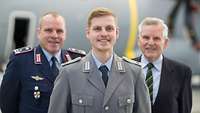
History of the Bundeswehr
It stretches from the armed forces in the Cold War era through German reunification to an army on operations.



It stretches from the armed forces in the Cold War era through German reunification to an army on operations.
Since its establishment in 1955, the Bundeswehr has been acting between the conflicting demands of defence policy, social change and international crises. Time and again, it has adapted to constantly changing framework conditions ranging from the Cold War during its early days, to German reunification, to deployments outside Germany, and to the watershed in history.
The Bundeswehr, which was established in the midst of the tensions arising from the Cold War, became a defensive army in the western alliance, and subsequently, an “Army of Unity” after German reunification. In the 1990s, the Bundeswehr developed into an army on operations through its participation in international missions. Deployed “out of area”, i.e. outside NATONorth Atlantic Treaty Organization territory, the armed forces took on new tasks and new responsibilities in the field of international conflict management. Missions abroad such as those in Mali and, in particular, Afghanistan caused a change in the way the forces saw themselves. For the first time, they had to prevail in combat. Bundeswehr soldiers were wounded or killed in action.
Since the so-called “Zeitenwende”, the watershed moment of Russia’s invasion of Ukraine, the Bundeswehr has started to refocus more closely on its core mission of defending Germany and NATONorth Atlantic Treaty Organization territory. In the wake of Russia’s war of aggression against Ukraine, national and collective defence have returned to centre stage in structure, training and equipment. This change of strategic direction in security policy marks another historical turning point, making the Bundeswehr come full circle to the role it played at the time of its establishment.
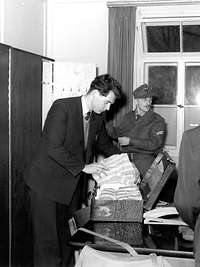
The Bundeswehr was founded just ten years after the end of the Second World War. However, a new confrontation had already begun.
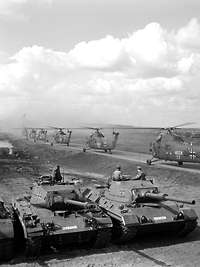
Within a few decades, the young Bundeswehr evolved into one of the strongest NATONorth Atlantic Treaty Organization forces during the Cold War

Facing the most demanding challenge in its history, the Bundeswehr has proven itself as an army of unity.
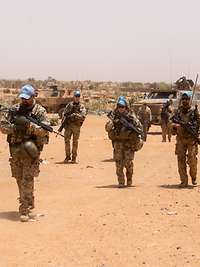
Threats do not respect national borders. This is why Bundeswehr soldiers are now deployed worldwide.
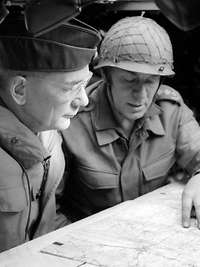
Armed forces must continue to change in order to meet new challenges. To this end, the Bundeswehr has been reformed many times.
The Bundeswehr is a complex organisation. Its biography began in the classical way with three Services, each with its own history and characteristics. Independently of each other, the Army, Air Force and Navy developed in the land, air and sea domains. At the same time, the three Services always worked closely together, regarding themselves as part of a single force. This is still the case today, for example when operating together during exercises or missions.
In the early days of the Bundeswehr, the Army was the Bundeswehr’s core service and, especially in the first few years, focused on national defence under the auspices of NATONorth Atlantic Treaty Organization. For a long time, its organisation, equipment and doctrine were based on the scenario of a potential conflict on German territory. After the end of the Cold War and the start of international operations in theatres ranging from the Balkans to Afghanistan and Mali, the alliance army with a deterrent mission developed into a worldwide deployable force with a global mission. Today, the Army is again preparing for a potential state of tension or a collective defence contingency – this time, presumably at NATONorth Atlantic Treaty Organization’s eastern flank.
From the very beginning, the Air Force played a particularly important role in military deterrence during the Cold War. In close cooperation with NATONorth Atlantic Treaty Organization partners, it performed airspace defence tasks and provided its capabilities for the nuclear element of Alliance strategy. Later, it assumed additional tasks such as air transport, air reconnaissance and ensuring protection against airborne threats. In technical, strategic and organisational terms, the Air Force evolved into a new role as a “high-tech service”. Today, the Air Force increasingly confronts threats in space and those posed by unmanned systems.
The Navy was formerly known as the “Federal Navy”, mainly operating in the North Sea and the Baltic Sea. Renamed the German Navy, it took on new tasks after German reunification, and was deployed in many of the world’s seas on international missions and operations involving maritime security and the protection of global shipping routes. Today, the Navy is an integral part of multinational NATONorth Atlantic Treaty Organization, EUEuropean Union and UNUnited Nations task forces. It contributes to both national and collective defence and international crisis management.
Whether on land, in the air or at sea, the three traditional Services share one mission: protecting Germany and its partners. You can find out more about the history of the Services here:
The Cyber and Information Domain Service is the newest Bundeswehr service, the former major organisational element having grown steadily since it was established in 2017. In recognition of the importance of cyberspace, it was elevated in 2024 to become a separate Bundeswehr service. Now the fourth Service, assets previously distributed across the entire Bundeswehr were pooled in the Cyber and Information Domain Service: ITInformationstechnik specialists, reconnaissance units, electronic warfare personnel and operators in the digital realm.
In an increasingly networked world, it has become apparent that a holistic approach to Germany’s security has to be taken, which must not be limited by geographic boundaries but also take account of cyberspace and digital infrastructure.
The end of the Cold War resulted in a fundamental change in the nature of military tasks. Instead of static national defence, the focus shifted to operations abroad, international cooperation and global logistics. The Bundeswehr responded to these changes by implementing comprehensive structural reforms such as the establishment of the Joint Support and Enabling Service and the Bundeswehr Joint Medical Service.
In early 2025, these two major organisational elements were combined into the Bundeswehr Joint Support Command. The aim of this reorganisation is to achieve a more efficient structure that better reflects operational reality, that is more resilient to crises, that defines responsibilities more clearly, and that is capable of reacting more quickly should the need for national and collective defence measures arise. The previous parallel existence of different support elements has ended to give way to integrated command and control and enhanced operational readiness.
In 2024, the command and control of missions abroad, operations within Germany, and national and collective defence operations was centralised in the Bundeswehr Joint Force Command, which was born out of the Bundeswehr Joint Forces Operations Command (responsible for missions abroad) and the Bundeswehr Homeland Defence Command (responsible for operations on German territory). The Bundeswehr Joint Force Command provides “single command”, its purpose being to ensure the Bundeswehr’s consistent focus on the requirements of national and collective defence. It also exercises command and control over the 16 Bundeswehr regional territorial commands.
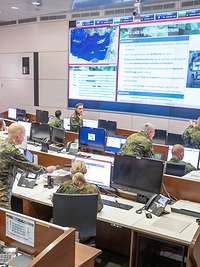
In future, the Bundeswehr will plan and conduct its operations at home and abroad from a single command in Berlin and Schwielowsee.